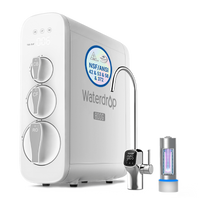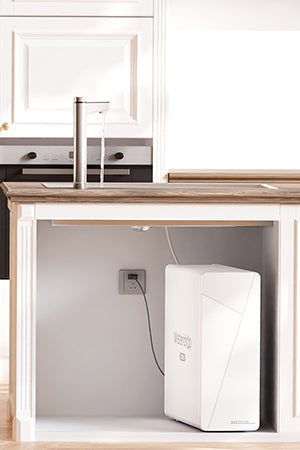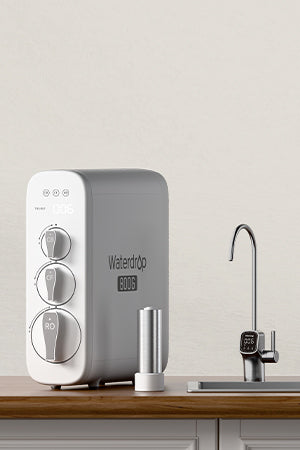L'eau est un besoin fondamental pour la survie humaine et un élément vital de notre quotidien. Il existe de nombreux types d'eau disponibles sur le marché, mais les plus connus sont l'eau bouillie et l'eau distillée. Bien que chacune d'elles subisse des processus qui modifient sa composition, des questions continuent de se poser quant à leurs différences et similitudes.
Dans cette étude, nous étudions les processus de mijotage et de distillation, mettant en lumière les modifications que chaque méthode apporte à l'eau. Nous souhaitons ainsi démystifier l'idée reçue selon laquelle l'eau bouillie est-elle identique à l'eau distillée ?
Qu'est-ce que l'eau distillée ?
L'eau distillée est le résultat d'un processus de purification laborieux appelé
distillation . Cette méthode consiste à chauffer l'eau pour produire de la vapeur, qui se refroidit et se concentre à l'état liquide. La capacité de la distillation à éliminer les minéraux et les contaminants de l'eau tout en extrayant sa forme la plus pure fait sa qualité remarquable.
L'osmose inverse, la chloration et la filtration sont des méthodes de purification de l'eau plus efficaces que la distillation. Un
système d'osmose inverse est la méthode la plus efficace pour purifier l'eau du robinet dans les résidences dépendantes des sources d'eau publiques.
Système d'osmose inverse sans réservoir 800 GPD avec lumière stérilisante UV - Waterdrop G3P800
1199,0 $
La distillation élimine les contaminants de l'eau, lui conférant un niveau de pureté remarquable. Ses applications sont multiples, notamment médicinales, scientifiques et pour les appareils électroménagers nécessitant une eau faiblement minéralisée. D'une pureté inégalée, l'eau distillée est idéale pour les entreprises exigeant une précision extrême.
Quel est le pH de l’eau distillée ?
Il est essentiel de rappeler que l'eau n'a pas un pH de 7 à l'état naturel, qu'elle soit distillée, déionisée ou du robinet. Lorsque le dioxyde de carbone (CO2) est exposé à l'air, il se dissout dans l'eau et forme de l'acide carbonique. Par conséquent, le pH réel de l'eau est souvent différent de 7.
Cliquez pour en savoir plus sur
ce qu’est l’eau déionisée .
Qu'est-ce que l'eau bouillie ?
L'eau du robinet bouillie est un liquide porté à ébullition puis refroidi sans intervention artificielle. Diverses bactéries et parasites présents dans l'eau non traitée peuvent être à l'origine de maladies. Il est conseillé de consommer de l'eau cuite, car l'ébullition permet d'éliminer efficacement les parasites et les bactéries présents dans l'eau.
L'homme utilise l'eau bouillante depuis des millénaires pour éliminer les impuretés et les polluants. Cependant, l'efficacité de l'eau bouillante comme méthode de purification demeure incertaine. Où que vous soyez, que ce soit dans une région reculée ou chez vous, faire bouillir l'eau est une méthode simple et très efficace pour la purifier.
À quelle température l'eau bout-elle ?
Atteindre une température de 100 °C lors de l'ébullition est essentiel pour éliminer les bactéries nocives. La plupart des bactéries peuvent être éliminées dans une eau à plus de 71 °C pendant trente minutes.
Les gouvernements pourraient émettre un
avis d'ébullition de l'eau lors de catastrophes naturelles afin de garantir la salubrité de l'eau. Cette mesure préventive protège la santé publique en neutralisant les micro-organismes dangereux et en éliminant les polluants potentiels. Faire bouillir l'eau est une méthode simple mais efficace pour garantir sa salubrité et minimiser les risques potentiels pour la santé en cas de circonstances défavorables.
En quoi l'eau bouillie diffère de l'eau distillée
Procédure de purification
L'ébullition est une procédure simple et efficace qui consiste à porter l'eau à température jusqu'à son point d'ébullition. Le traitement thermique élimine efficacement les bactéries dangereuses, garantissant ainsi la salubrité de l'eau. Bien qu'il résolve les problèmes microbiens, il n'élimine pas les minéraux et autres impuretés présents dans l'eau.
La distillation est une technique de purification plus sophistiquée. L'eau se vaporise lorsqu'elle est chauffée, éliminant ainsi les minéraux et les impuretés, puis se liquéfie. Grâce à une approche systématique, ce procédé garantit l'élimination complète des impuretés, produisant une eau d'une pureté exceptionnelle, notamment exempte de minéraux et autres polluants.
Composition minérale
Les minéraux présents dans l'eau du robinet sont conservés dans l'eau bouillante. La composition minérale de l'eau reste inchangée tout au long du processus d'ébullition, car les minéraux ne sont pas éliminés. La saveur et la composition globale de l'eau du robinet peuvent être influencées par sa concentration en minéraux.
À l'inverse, l'eau distillée est dépourvue de minéraux. Elle est soumise à une distillation pour éliminer les minéraux et autres contaminants, ce qui réduit considérablement sa teneur en minéraux. Grâce à sa pureté, l'eau distillée peut être utilisée dans des applications sans minéraux, comme la recherche médicale ou scientifique.
Impact sur les micro-organismes
Faire bouillir l'eau est une technique efficace pour éliminer les micro-organismes nocifs. L'ébullition entraîne la décomposition des virus, bactéries et autres micro-organismes nocifs, la rendant propre à la consommation humaine. Cette méthode est particulièrement utile en cas de risque de maladies d'origine hydrique.
La distillation est une méthode efficace pour éliminer les microbes. Les contaminants, tels que les bactéries, sont éliminés en transformant l'eau en vapeur, puis en la condensant à nouveau à l'état liquide. Dans les contextes où le maintien de la pureté microbiologique est primordial, l'eau distillée garantit une eau totalement exempte de polluants biologiques, ce qui en fait un choix fiable.
Goût et odeur
Les saveurs des impuretés présentes dans l'eau d'origine peuvent persister dans l'eau bouillie. La présence de minéraux, de substances chimiques et d'autres éléments dans l'eau d'origine peut influencer les caractéristiques gustatives de l'eau, car l'ébullition n'élimine pas les constituants liés au goût.
L'eau distillée se caractérise souvent par son absence de saveur ou d'odeur. La distillation est un procédé qui élimine les substances chimiques volatiles, les minéraux et les contaminants susceptibles d'altérer le goût et l'odeur.
L'eau déionisée est souvent inodore et sans goût, ce qui en fait un choix idéal pour obtenir une eau transparente et neutre.
Applications
L'eau portée à ébullition est une option courante, tant pour boire que pour cuisiner. L'un de ses principaux avantages est qu'elle élimine les bactéries nocives, ce qui permet de l'utiliser pour préparer des aliments et des boissons. Faire bouillir l'eau est une méthode qui garantit la salubrité de l'eau utilisée au quotidien.
L'eau distillée est privilégiée dans les environnements spécialisés où une grande pureté est primordiale, comme les laboratoires et les opérations médico-chirurgicales. Ne contenant ni minéraux ni autres contaminants, l'eau purifiée est un solvant fiable, utilisable dans de nombreux projets de recherche scientifique et pour les dispositifs médicaux. Elle prévient également l'accumulation de tartre dans les fers à vapeur et autres appareils électroménagers utilisant de l'eau déminéralisée.
Comment faire de l’eau distillée ?
Certaines personnes peuvent se demander comment distiller l'eau dans leur région. Il est possible de produire de l'eau distillée à la maison, mais on en trouve également en vente dans les magasins et autres commerces de détail. Voyons maintenant comment produire de l'eau purifiée à la maison.
Afin d'accomplir la tâche de production d'eau distillée à la maison, les éléments suivants doivent être préparés, les éléments suivants sont requis :
- Une grande casserole avec un couvercle
- Un bol plus petit
- Glace
- Eau
Remplissez votre casserole d'eau à moitié. Placez un bol vide dans votre casserole. Le bol doit rester à distance du fond de la casserole, évitant ainsi tout contact ou immersion. Idéalement, il devrait être plus petit que la casserole, afin de pouvoir flotter à la surface de l'eau. Réglez le feu sur une température modérée et portez l'eau à ébullition. Ensuite, retournez le couvercle et placez-le sur la casserole, puis ajoutez des glaçons jusqu'au bord.
Lorsque la vapeur générée par l'eau bouillante entre en contact avec le couvercle froid, elle se condense. Lorsque la condensation s'égoutte dans le récipient, vous obtenez de l'eau purifiée. Poursuivez la distillation jusqu'à obtenir la quantité d'eau nécessaire.
L’eau distillée est-elle potable ?
Peut-on boire de l'eau distillée ? Bien que l'eau distillée soit considérée comme propre à la consommation, il existe de meilleures options pour une consommation régulière. La distillation est un procédé permettant d'éliminer les minéraux, les contaminants et les impuretés de l'eau, produisant ainsi une eau très pure. Cependant, en raison de leur absence, l'eau distillée ne possède pas le goût et les bienfaits pour la santé que peuvent apporter des minéraux comme le calcium et le magnésium.
L'utilisation intermittente d'eau distillée est généralement considérée comme sûre. Cependant, s'en servir à long terme comme principale source d'hydratation peut être une meilleure solution. Adopter une stratégie équilibrée en matière de consommation d'eau, incluant diverses sources d'eau pour assurer l'apport en minéraux essentiels par l'alimentation, est souvent conseillé.














































































